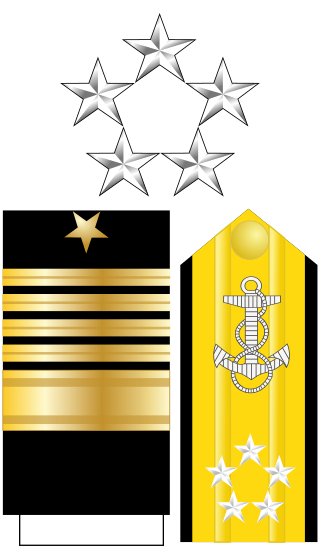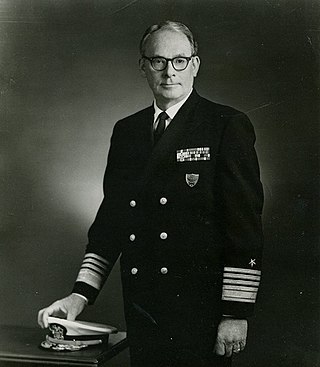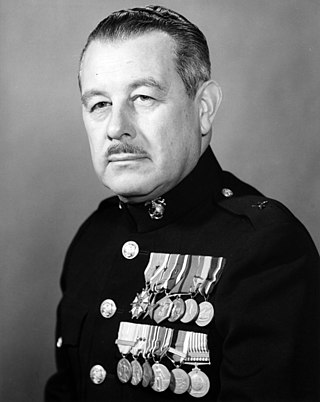
The National War College (NWC) of the United States is a school in the National Defense University. It is housed in Roosevelt Hall on Fort Lesley J. McNair, Washington, D.C., the third-oldest Army post still active.

Chester William Nimitz was a fleet admiral in the United States Navy. He played a major role in the naval history of World War II as Commander in Chief, US Pacific Fleet, and Commander in Chief, Pacific Ocean Areas, commanding Allied air, land, and sea forces during World War II.

William Frederick "Bull" Halsey Jr. was an American Navy admiral during World War II. He is one of four officers to have attained the rank of five-star fleet admiral of the United States Navy, the others being William Leahy, Ernest King, and Chester W. Nimitz.

Raymond Ames Spruance was a United States Navy admiral during World War II. He commanded U.S. naval forces during one of the most significant naval battles that took place in the Pacific Theatre: the Battle of the Philippine Sea. He also commanded Task Force 16 at the Battle of Midway, comprising the carriers Enterprise and Hornet. At Midway, dive bombers from the Enterprise crippled sank four larger carriers of the Imperial Japanese Navy. Most historians consider Midway the turning point of the Pacific War.

The Naval War College is the staff college and "Home of Thought" for the United States Navy at Naval Station Newport in Newport, Rhode Island. The NWC educates and develops leaders, supports defining the future Navy and associated roles and missions, supports combat readiness, and strengthens global maritime partnerships.

Fleet admiral is a five-star flag officer rank in the United States Navy whose rewards uniquely include active duty pay for life. Fleet admiral ranks immediately above admiral and is equivalent to General of the Army and General of the Air Force.

William Sowden Sims was an admiral in the United States Navy who fought during the late 19th and early 20th centuries to modernize the navy. During World War I, he commanded all United States naval forces operating in Europe. He also served twice as president of the Naval War College.

John Henry Towers CBE was a highly decorated United States Navy four-star admiral and pioneer naval aviator. He made important contributions to the technical and organizational development of naval aviation from its beginnings, eventually serving as Chief of the Bureau of Aeronautics (1939–1942). He commanded carrier task forces during World War II, and retired in December 1947. He and Marc Mitscher were the only early Naval Aviation pioneers to survive the hazards of early flight to remain with naval aviation throughout their careers. Towers spent his last years supporting aeronautical research and advising the aviation industry.

Thomas Cassin Kinkaid was an admiral in the United States Navy, known for his service during World War II. He built a reputation as a "fighting admiral" in the aircraft carrier battles of 1942 and commanded the Allied forces in the Aleutian Islands Campaign. He was Commander Allied Naval Forces and the Seventh Fleet under General of the Army Douglas MacArthur in the Southwest Pacific Area, where he conducted numerous amphibious operations, and commanded an Allied fleet during the Battle of Leyte Gulf, the largest naval battle of World War II and the last naval battle between battleships in history.
Hispanics in the United States Naval Academy account for the largest minority group in the institution. According to the academy, the Class of 2009 includes 271 (22.2%) minority midshipmen. Out of these 271 midshipmen, 115 are of Hispanic heritage. In 2004, of the total of 736 female midshipmen, 74 (10%) of them were of Hispanic descent.

The President's House is the home of the President of the Naval War College in Newport, Rhode Island. The house is a wooden, three-story building in Colonial Revival style located on a hill on Coaster's Harbor Island, overlooking Coaster's Harbor, Dewey Field, and Narragansett Bay.

Richard Gary Colbert was a four-star admiral in the United States Navy who served as President of the Naval War College from 1968 to 1971, and as commander in chief of all NATO forces in southern Europe from 1972 to 1973. He was nicknamed "Mr. International Navy" as one of the very few senior admirals in the U.S. Navy identified with international naval cooperation during the Cold War.

Admiral Charles Maynard "Savvy" Cooke Jr., USN, was a United States Navy four star admiral who saw service in World War I and World War II and later served as commander of United States Seventh Fleet (COMSEVENTHFLT) from 1946 to 1947 and commander of U.S. Naval Forces, Western Pacific (COMNAVWESPAC) from 1947 to 1948.
Lieutenant Commander B. Mitchell Simpson III, U.S. Navy (Ret.), was a professor of law, attorney, former naval officer, and naval historian, who is best known for his biography of Admiral Harold R. Stark.

Bankson Taylor Holcomb Jr. was a decorated officer of the United States Marine Corps with the rank of brigadier general. He is most noted for his service as cryptanalyst and Linguist for Admirals Halsey and Spruance during the Pacific War or as Intelligence Officer of the 1st Marine Division during the Korean War. He was also a cousin of Commandant of the Marine Corps General Thomas Holcomb.

Bernard Franklin Roeder was a decorated officer in the United States Navy with the rank of vice admiral, who held many important assignments, including commander in chief of United States First Fleet and Director of Naval Communications. He also served as first director of the Naval Security Group.
Charles Johnes ‘Carl' Moore was a Rear Admiral of the United States Navy. He was the chief of staff of Raymond A. Spruance, commander of the Fifth Fleet, during the most important and significant naval campaigns of the World War II in the Pacific Theater: the Gilberts, the Marshalls and the Marianas.

Hugh Hilton Goodwin was a decorated officer in the United States Navy with the rank of Vice Admiral. A veteran of both World Wars, he commanded escort carrier USS Gambier Bay (CVE-73) during the Mariana Islands campaign. Goodwin then served consecutively as Chief of Staff, Carrier Strike Group 6 and as Air Officer, Philippine Sea Frontier and participated in the Philippines campaign in the later part of the War.















